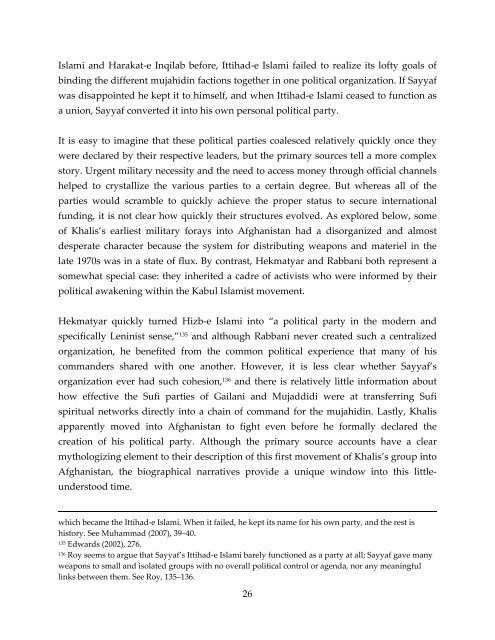Usama bin Ladin’s “Father Sheikh”:
Usama bin Ladin’s “Father Sheikh”:
Usama bin Ladin’s “Father Sheikh”:
Create successful ePaper yourself
Turn your PDF publications into a flip-book with our unique Google optimized e-Paper software.
Islami and Harakat‐e Inqilab before, Ittihad‐e Islami failed to realize its lofty goals of<br />
<strong>bin</strong>ding the different mujahidin factions together in one political organization. If Sayyaf<br />
was disappointed he kept it to himself, and when Ittihad‐e Islami ceased to function as<br />
a union, Sayyaf converted it into his own personal political party.<br />
It is easy to imagine that these political parties coalesced relatively quickly once they<br />
were declared by their respective leaders, but the primary sources tell a more complex<br />
story. Urgent military necessity and the need to access money through official channels<br />
helped to crystallize the various parties to a certain degree. But whereas all of the<br />
parties would scramble to quickly achieve the proper status to secure international<br />
funding, it is not clear how quickly their structures evolved. As explored below, some<br />
of Khalis’s earliest military forays into Afghanistan had a disorganized and almost<br />
desperate character because the system for distributing weapons and materiel in the<br />
late 1970s was in a state of flux. By contrast, Hekmatyar and Rabbani both represent a<br />
somewhat special case: they inherited a cadre of activists who were informed by their<br />
political awakening within the Kabul Islamist movement.<br />
Hekmatyar quickly turned Hizb‐e Islami into “a political party in the modern and<br />
specifically Leninist sense,” 135 and although Rabbani never created such a centralized<br />
organization, he benefited from the common political experience that many of his<br />
commanders shared with one another. However, it is less clear whether Sayyaf’s<br />
organization ever had such cohesion, 136 and there is relatively little information about<br />
how effective the Sufi parties of Gailani and Mujaddidi were at transferring Sufi<br />
spiritual networks directly into a chain of command for the mujahidin. Lastly, Khalis<br />
apparently moved into Afghanistan to fight even before he formally declared the<br />
creation of his political party. Although the primary source accounts have a clear<br />
mythologizing element to their description of this first movement of Khalis’s group into<br />
Afghanistan, the biographical narratives provide a unique window into this little‐<br />
understood time.<br />
which became the Ittihad‐e Islami. When it failed, he kept its name for his own party, and the rest is<br />
history. See Muhammad (2007), 39–40.<br />
135 Edwards (2002), 276.<br />
136 Roy seems to argue that Sayyaf’s Ittihad‐e Islami barely functioned as a party at all; Sayyaf gave many<br />
weapons to small and isolated groups with no overall political control or agenda, nor any meaningful<br />
links between them. See Roy, 135–136.<br />
26


